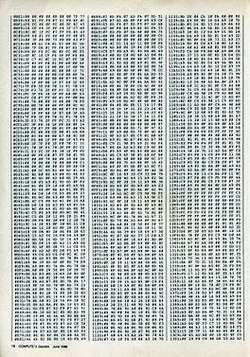MLX (software)
MLX is a series of machine language entry utilities published by the magazines COMPUTE! and COMPUTE!'s Gazette, as well as books from COMPUTE! Publications. These programs were designed to allow relatively easy entry of the type-in machine language listings that were often included in these publications. Versions were available for the Commodore 64, VIC-20, Atari 8-bit family, and Apple II. MLX listings were reserved for relatively long machine language programs such as SpeedScript.
First version

MLX was introduced in the December 1983 issue of COMPUTE! for the Commodore 64 and Atari 8-bit family.[1] This was followed in the January 1984 issue of COMPUTE!'s Gazette by a version for the VIC-20 with 8K expansion,[2] and in the March 1984 issue by Tiny MLX, a version for the unexpanded VIC-20.[3] These use a format consisting of six data bytes in decimal format, and a seventh as a checksum. The program auto-increments the address and prints the comma delimiters every three characters. Invalid keystrokes are ignored.
In the Commodore version, beginning in the May 1984 issue of COMPUTE!, several keyboard keys are redefined to create a makeshift numeric keypad.[4]
Improved version
A new version of MLX was introduced for the Apple II in the June 1985 issue.[5] This version uses an 8-byte-per-line hexadecimal format. A more sophisticated algorithm was implemented to catch errors overlooked by the original.
The improved features were then backported to the Commodore 64. The new version, known on the title screen as "MLX II", but otherwise simply as "the new MLX", appeared in the December 1985 issue of COMPUTE!.[6] It was printed in COMPUTE!'s Gazette the following month.[7] This version of MLX was used until COMPUTE!'s Gazette switched to a disk-only format in December 1993.
See also
- The Automatic Proofreader – COMPUTE!'s checksum utility for BASIC programs
References
- Charles Brannon, "MLX: Machine Language Entry Program For Atari And Commodore 64", COMPUTE!, December 1983, p. 216
- Brannon, Charles (January 1984). "MLX Machine Language Entry Program For Commodore 64 And VIC-20". COMPUTE!'s Gazette. Greensboro, North Carolina: COMPUTE! Publications. p. 171. Retrieved 2018-03-26.
- Brannon, Charles (March 1984). "Notes on VIC Tiny MLX". COMPUTE!'s Gazette. Greensboro, North Carolina: COMPUTE! Publications. p. 48. Retrieved 2018-03-26.
- Brannon, Charles (May 1984). "MLX Machine Language Entry Program For Commodore 64". COMPUTE!'s Gazette. Greensboro, North Carolina: COMPUTE! Publications. p. 181. Retrieved 2018-03-26.
- Tim Victor, "Apple MLX: Machine Language Entry Program", COMPUTE!, June 1985, p. 114
- Ottis Cowper, "The New MLX: Enhanced Machine Language Editor for the Commodore 64", COMPUTE!, December 1985, p. 74
- Cowper, Ottis. "The New MLX: Enhanced Machine Language Editor for the Commodore 64". COMPUTE!'s Gazette. Greensboro, North Carolina: COMPUTE! Publications. p. 42. Retrieved 2018-03-27.